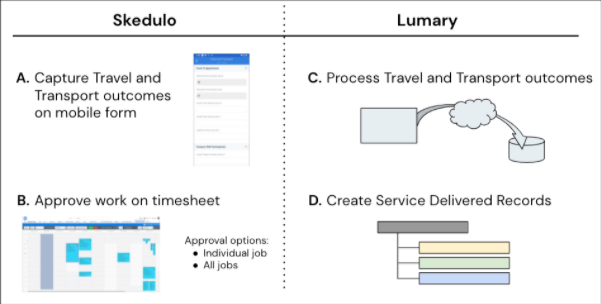How Travel and Transport data is used for billing
Lumary enables providers to accurately bill clients for travel time and transport services rendered by workers. This involves capturing specific details related to the journey, which, combined with correct service setup and service agreements, allows Lumary to generate billable Service Delivery records upon job completion and approval. While data capture can occur directly in Lumary, best practice is having employees record their travel and transport information via the Travel and transport mobile form in the Skedulo mobile app.
There are four key steps in the capture and use of Travel and Transport information for creation of Lumary service delivered records:
- Skedulo enables workers to capture the relevant travel and transport information using the Skedulo mobile app.
- For customers using the Skedulo Timesheet Console, the worker’s manager views and audits the Travel and Transport form data on the Timesheet console.
- The captured and approved Travel and Transport data is passed to Lumary for processing.
- Lumary uses the processed Travel and Transport information to create the required Lumary Service Delivered records.

Fig: How Skedulo and Lumary work together for travel and transport
Before travel and transport can be charged, ensure the service agreement is configured correctly in Lumary
Data Capture: The Travel and Transport Form
Details required for billing are typically captured by the worker in the mobile app, often using the Travel and transport mobile form. This form can include the following sections to capture:
- Travel To Appointment: Records details about the worker’s journey to the client appointment. This often includes:
- Start/End times or Duration.
- Total Distance Travelled (KMs).
- Any additional costs incurred (e.g., tolls).
- Transport With Participant(s): Records details when the worker transports the client during the appointment. This may include:
- Start/End times or Duration.
- Total Distance Travelled (KMs).
- Vehicle used.
- Any additional costs incurred (e.g., parking, tolls).
- Travel From Appointment: Records details about the worker’s journey from the client appointment back towards their next destination or home base. Similar details to “Travel To” are captured.
Note: The specific fields and visibility of these sections might be configurable based on your organisation’s setup and the rules defined (e.g., only showing “Travel To” for the first job of the day).
Logic and Apportionment
The data captured in the Travel and Transport form is used by Lumary, potentially applying specific apportionment logic, to determine the final billable amounts
Generating Service Delivery Records
All services to be charged to a client are stored against the Job Service Item (JSI) object. Once the work is finalised, these JSI records (along with other data against the Job Allocation and Group Attendee objects) can be triggered and passed to Lumary to generate all the required Service Delivery records.
The solution has a custom setting which determines when the Lumary trigger is called. The three options can fire the tigger;
- As soon as the job is moved into the completed status
- When the resources job is approved in the timesheet console
- When the resources whole timesheet is approved in the timesheet console
If the tigger is called based on the timesheeting process, users can have the opportunity to audit the travel and transport form data before the Lumary trigger is called.